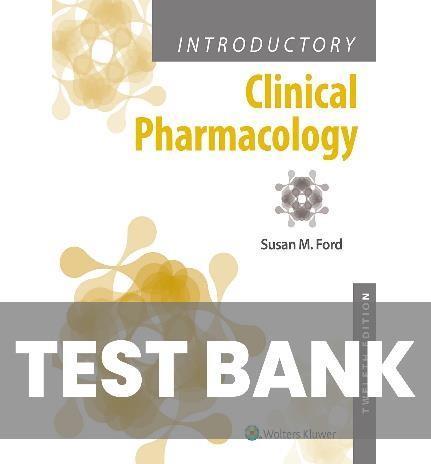1. A nursing instructor is preparing a teaching plan for a group of nursing students about pharmacology. When describing this topic, the instructor would focus the discussion onwhich of the following as an essential aspect?
A) Drug name
B) Drug class
C) Drug action
D) Drug source
Ans: C
Feedback:
Pharmacology is the study of drugs and their action on living organisms. Thus, an essentialaspect ofpharmacology is drug action. An understanding ofthe drug name,drug class, and drug source is important, but the most critical aspect related to pharmacology is how the drug acts in the body.
2. A nursing student is preparing to administer a prescribed drug to a patient. The student reviews information about the drug and its actions. Which ofthe following would be the best choice for obtaining this information? Select all that apply.
A) Nursing instructor
B) Nurse assigned to the patient
C) Clinical drug reference
D) Prescribing health care provider
E) Clinicalpharmacist
Ans: C, E
Feedback:
Although the nursing student can ask the nursing instructor, the nurse assigned to the patient, and the prescribing health care provider for information about the drug,the best choices for drug information would include an appropriate drug reference and the clinical pharmacist.
3. When describing the various types of medications to a groupof nursing students, a nursing instructor would identify which of the following as a source for deriving medications? Select all that apply.
A) Plants
B) Synthetic sources
C) Mold
D) Minerals
E) Animals
Ans: A, B, C, D, E
Feedback:
Medications are derived fromnaturalsources, for example, plants, molds, minerals, and animals, as well as created synthetically in a laboratory.
Download All Chapters At : https://nursingrade.com/product/introductory-clinical-pharmacology-12thedition-susan-m-ford-test-bank/

4. Which ofthe following names may be assigned to a drug during the process of development? Select all that apply.
A) Chemical name
B) Official name
C) Pharmacologic name
D) Trade name
E) Nonproprietary name
Ans: A, B, D, E
Feedback:
Throughout the process of development, drugs may have several names assigned to them including a chemical name, a generic (nonproprietary) name, an official name, and a tradeor brand name.
5. Adrug may be classified bywhich ofthe following? Select allthat apply.
A) The chemicaltype ofthe drug's active ingredient
B) The waythe drug is used to treat a specific condition
C) The generic name ofthe drug
D) The trade name of the drug
E) The nonproprietary name of the drug
Ans: A, B
Feedback:
A drug may be classified bythe chemical type ofthe active ingredient or bythe way it is used to treat a particular condition. Generic, trade, and nonproprietary refer to how a drug is named.
6. A group of nursing students are reviewing information about the process of drug development in the United States. The students demonstrate understanding of this process when they identify that which ofthe following categories are assigned bythe Food and Drug Administration to newly approved drugs? Select allthat apply.
A) Metabolite
B) Noncontrolled substance
C) Prescription
D) Nonprescription
E) Controlled substance
Ans: C, D, E
Feedback:
Once drugs are approved for use, the FDA assigns the drug to one of the following categories: prescription, nonprescription, or controlled substance. Metabolite refers to the inactive formof the drug. Noncontrolled substance is a termthat is not used.
Download All Chapters At : https://nursingrade.com/product/introductory-clinical-pharmacology-12thedition-susan-m-ford-test-bank/
7. Which ofthe following would be most important forthe nurse to do to ensure the safe use of prescription drugs in the institutional setting? Select all that apply.
A) Administering drugs
B) Monitoring clients for drug effects
C) Prescribing drugs
D) Evaluating clients for toxic effects
E) Educating clients/caregivers about drugs
Ans: A, B, D, E
Feedback:
In the institutional setting, the nurse's role to ensure safe use of prescription drugs includes administering drugs, monitoring drug effects, evaluating for toxic effects, and educating clients and caregivers about drugs.
8. The nurse is helping a client review a prescription fromthe health care provider. When examining the prescription, which of the following would the nurse expect to find documented? Select all that apply.
A) Name of the drug
B) Dosage of the drug
C) Routeofdrug administration
D) Times ofdrug administration
E) Licensed prescriber's signature
Ans: A, B, C, D, E
Feedback:
The prescription must contain the client's name, the name ofthe drug, the dosage, the method and times of administration, and the signature of the licensed health care provider prescribing the drug.
9. After teaching a group of nursing students about nonprescription drugs, the nursing instructor determines that the teaching was successfulwhen the students identify which ofthe following? Select all that apply.
A) Theyrequire a licensed health care provider's signature.
B) Theyare referred to as over-the-counter drugs.
C) Theycan be taken without risk to the client.
D) Theyhave certain labeling requirements.
E) They should be taken only as directed on the label.
Ans: B, D, E
Feedback:
Nonprescription drugs are often referred to as over-the-counter (OTC) drugs. They do not require a prescription (a licensed health care provider's signature) but do not come without risk to the client. The federalgovernment has imposed labeling requirements of OTC drugs and they should only be taken as directed on the label unless under the supervision of a health care provider.
